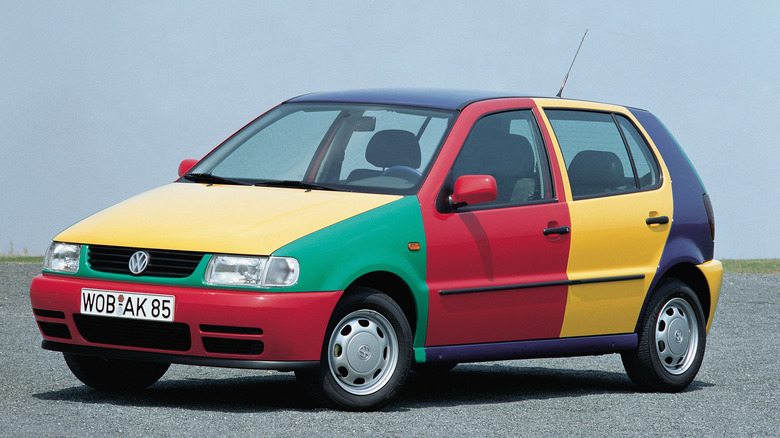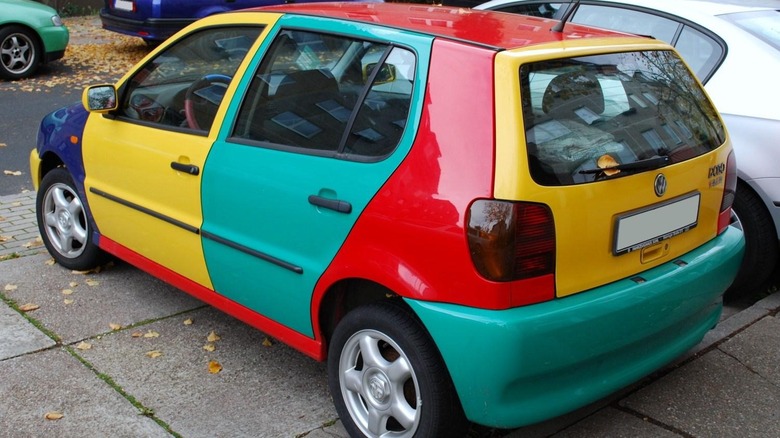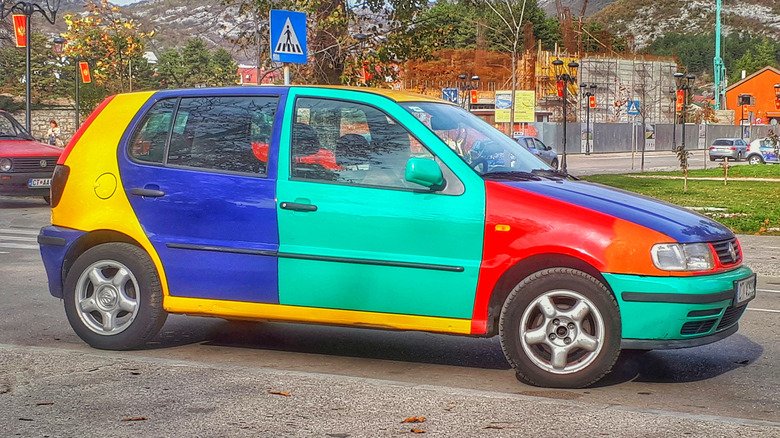The Story Behind Volkswagen's Strange Polo Harlequin
The Oxford English Dictionary defines harlequin as "a mute character in traditional pantomime, typically masked and dressed in a diamond-patterned costume." Nowadays, the word typically refers to something that has many different colors, but until 1995, it would have been difficult to imagine using the adjective to describe a car.
There are a couple of takes on how the circus-quilt Polo Harlequin — spelled Harlekin in certain parts of the world — came to be a real thing. The first theory goes that Volkswagen staff was inspired by a brochure featuring color-coded "building blocks" that illustrated the multitude of ways that the new third-generation Polo could be optioned and personalized by potential buyers. For example, engine choices were assigned a blue block, special equipment had a red theme, and so on.
Other VW enthusiasts hold firm that the Harlequin concept was unceremoniously lifted directly from a 1960s print advertisement showing a multi-hued Volkswagen Beetle. The Beetle in the ad not only had different colored body panels, but they were also from different model years, ranging from 1958-1964. The advertisement was intended to highlight the ease of availability and compatibility of replacement parts for the Beetle
Whichever version of the origin story that you prefer, a handful of eye-catching Polo Harlequins were cobbled together for promotional use, including at the 1995 Frankfurt Motor Show. Fans were so enthusiastic that Volkswagen decided to sell a limited number of production versions of the car.
The color combinations were assigned to buyers at random
As you might have guessed, there were multiple combinations of how the body panels were arranged. The roof, C-pillar, and door sills betray which solid color that particular Polo started life as since those structural components couldn't be altered. Beyond that, the remaining removable panels were swapped from vehicle to vehicle post-assembly line to create four different versions. Reportedly, the rearranging was done by hand and was quite labor-intensive.
Harlequin buyers had no say in specifying which of the four colorways they would receive. This lack of choice was painted positively (pun intended) by the car company as fostering an element of surprise. Still, far more likely, it was meant to reduce the waste that would result if too many folks wanted a particular color scheme. The official names of the four intermixed colors were Chagall Blue, Ginster Yellow, Pistachio Green, and Tornado Red.
[Featured image by Thomas doerfer via Wikimedia Commons | Cropped and scaled | CC BY-SA 3.0]
It was way more popular than anticipated
Besides the schizophrenic paint job, Harlequin Polos were equipped with unique grey cloth upholstery, speckled with all four body colors. Other features standard to the Harlequin included an airbag, sport bumpers from the GLX trim level, and a combination of clear and smoked covers for exterior lighting.
Volkswagen had set out to produce exactly 1,000 of the Polo Harlequin. Still, in the end, demand was so great that an estimated 3,806 were made, including 500 that were awarded as prizes in a promotion with fast-food giant McDonald's. Per the company, the new cost was approximately $13,000, equal to $26,000 in today's dollars.
The Polo was never sold in the United States, but in 1996, Americans caught a dose of Harlequin fever when a multicolor version of the larger Golf was marketed here. It's a legitimately rare specimen, with only 264 made.
A quarter-century later, in 2021, Volkswagen rolled out a single additional Harlequin unit to highlight a mid-cycle refresh of the sixth-generation Polo. Not by coincidence, it was unveiled on Blue Monday — the third Monday in January and supposedly the saddest day of the year — to spread cheer.


